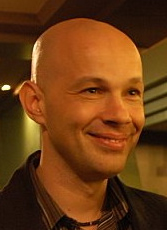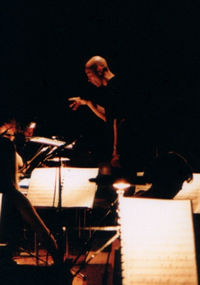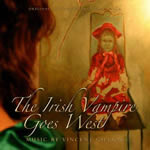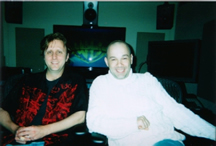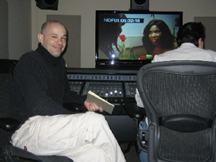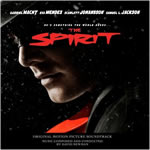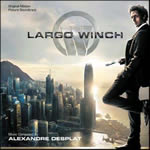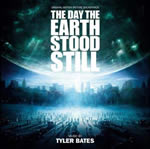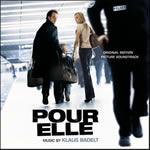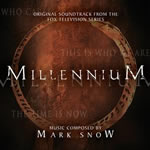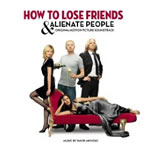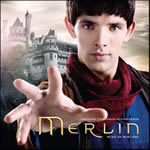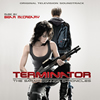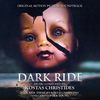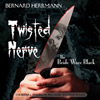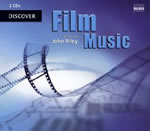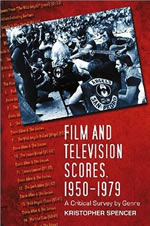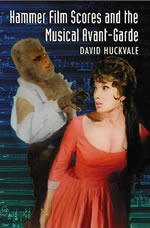 |
Soundtrax: Episode 2008-23
January 2, 2009
By Randall D. LarsonIrish I Were a Vampire
Reviews this week headline with David Newman’s gritty score for The Spirit, Frank Miller’s intriguing interpretation of Will Eisner’s iconic comic noir hero (“one of Newman’s best scores and shows him to be his father’s son: right at home in film noir”), Alexandre Desplat’s score for the French action/intrigue thriller, Largo Winch (“very much melody with muscles, a very fluid orchestral action score very nicely developed and executed”), Tyler Bates’ edgy score for the new version of The Day The Earth Stood Still (“a very satisfying progression of atmospheric development that retains the sense of largess coupled with elements of introspection”), Klaus Badelt’s score for the French thriller, Pour Elle (For Her) (“primarily an electronic score, Badelt’s proclivity for melody remains at the forefront”), La-La Land Record’s 2-disc collection of Mark Snow’s music from the TV series Millennium (“preserves some of the composer’s finest work to date”), David Arnold’s music for the romantic comedy, How To Lose Friends and Alienate People (“a pleasing romantic comedy, but fairly innocuous”), Laura Rossi’s new score for the special 90th Anniversary restoration of the 1916 British war film, The Battle of the Somme (“the music constantly flavors the documentary with a progressive energy and a reverence for the soldiers involved”), and Rob Lane’s music for the UK miniseries Merlin (“richly romantic and splendid swashbuckling, while evoking through mysterious chorale strains the more mystical elements of the Arthurian sorcerer”). We also take a look at two important new books about film music, and share the latest news about film scores and soundtracks from around the globe.
Film Music of Vincent Gillioz
Building a notable filmography of more than a dozen scores for independent and low-budget films (such as his delicate score for director/producer/editor/actress Pegarty Long’s absorbing horror fantasy, The Irish Vampire Goes West, the action thriller Cut Off, the edgy horror film Frost, and many more, including dozens of short film scores, Vincent Gillioz is establishing himself as a notable film composer to be reckoned with. Born in the French speaking city of Geneva, Switzerland, Gillioz grew up playing guitar in heavy metal bands, eventually refining his musical education and winding up in Los Angeles with Christopher Young as his film musical mentor.
Interviewed earlier this year, Gillioz described his background and his approach to film scoring.
(See the detailed review of his Irish Vampire score [“a fascinating score with a rich sound design and a very compelling musical structure, nicely conceived and executed”] in my June 6th column, at www.buysoundtrax.com/larsons_soundtrax_6_6_08.html)
Vincent Gillioz Q: What led you into film music – and what steps did you have to take to become professionally involved?
Vincent Gillioz: I went to Berklee in Boston to study the guitar. When I played in bands, we always composed the music that we played. It’s only when I was studying and practicing so much that I became aware that what I liked was not how well I could play, but which note to put after the other, which instrument will play it, the how, what, and when, in other words, composing. I have always loved the atmosphere that the music creates when I am sitting in a theater, and I always had a very strong love for movies. To write music for movies, you need to understand movies very well, it is first about the movie, not about the music.
Q: You worked closely with Christopher Young during your early days in Hollywood. What were the most important things you learned under his tutelage?
Vincent Gillioz: I met Chris a few months after I arrived in LA, at the Society of Composers and Lyricists Christmas Dinner where I volunteered. I went to Chris and just wanted to thank him for the great music he has been giving us for so many years. I know all his scores, including the most obscure ones. And he said that we should get together. I hadn’t expected anything like that, I’d just wanted to thank him. He listened to my demo CD and told me I should go to the Sundance Composers Lab. I was the only one he recommended that year, so I was very touched and honored. Once he lent me his studio to record. Chris Young a magnanimous person who is very supportive of aspiring composers. He started the Tilden House Residency, a unique residency program offering low cost housing in Los Angeles in order to help aspiring film composers and musicians establish themselves in Hollywood.
The best thing I learned from Chris is never to give up, and that the first thing you need to know is how to sell yourself.
Q: You wrote a thesis examining the collaborative relationship between noted directors and composers – Hitchcock/Herman, Godard/Duhamel, Marshall/Newman, etc. What is necessary for a composer and director to click in such a meeting of the minds, and is such an ongoing collaboration possible in today’s commercial moviemaking business environment?
Vincent Gillioz: I believe that what would help to make a director and a composer click is to have a similar approach on art in general, and this is not something a composer can prepare for. So since it is up to the director to hire a composer, when I have a meeting, I try to articulate as much as I can my approach, what are the musical options on a movie. The composer needs to show that he or she really knows what he or she is doing, because the director is usually clueless about the different options, and that it is also why he or she hires you. He or she wants someone who knows what he or she’s doing. Collaborations are still possible, and even more if it is a commercial environment. Producers who are making movies for commercial reasons love recipes of success, so if they have a team that was successful on one movie, they will feel safer hiring the same team again than taking a risk in changing the recipe of the previous success. We see new tandems appearing such as Abrams/Giacchino, Payne/Kent, Tony Scott/Gregson-Williams, Shyamalan/Howard, etc.
Q: What musical opportunities did your first few film scores present for you, and what challenges did they pose for you?
Vincent Gillioz: My first film scores were a great learning experience. They posed problems that I never thought of. I had only 18 days for my first feature. This was crazy because I didn’t have enough experience scoring movies or knowledge of my sample library to be able to work very fast. But in the end I made it, because I had to! It is very funny when I listen to my first scores, because they are too rich in themes, there were too many different things going on, because I was lacking perspective. I was putting everything in every cue. The musical opportunities were great, because I was very free of writing whatever I felt like. The limitations were the budget being very low, which meant no live players, and not being able to buy better sample libraries. So the sound of my first scores was not great. From those assignments I learned how to shape an evolution of the musical score over the whole movie, and how I had to write less different material, and to develop it more over the whole movie.
Q: The larger number of scores on your filmography have been for horror films, such as Scarecrow and Scarecrow Slayer, The Inn, The Campus House, Frost, Portal, Pray For Morning, which often called for a very unusual palette of electronics and orchestra (and several of these scores have won film festival awards). What is needed of music in today’s scary movies and what tools do you keep in your bag to accomplish it?
Vincent Gillioz: It is true that I have a lot of experience in horror movies, although it is not by choice. Most low budget movies made are in this genre, because it is a genre that doesn’t require name actors, and the success of the Blair Witch Project suddenly triggered a high demand. What is interesting in scoring scary movies is that it allows you to push the musical envelope. It is almost the only genre where you can use avant garde techniques and try very unusual things without being fired! At the same time you also need to be able to write more conventional music, because there’s a lot more than just scary moments in a horror movie. So you need a good knowledge of the contemporary techniques and the addition of a good electronic sample library would be a plus.
Q: While you’re not exclusively a composer for horror thrillers, you certainly have enough affinity for it to keep directors and producers coming back for more. How would you describe your personal style or approach at scoring contemporary horror films?
Vincent Gillioz: Today, to keep the flame fresh when scoring a movie, I try to score them differently than I’ve done before. For instance, when I scored The Irish Vampire Goes West, I decided to score it using only traditional Irish instruments. Hamal 18 was the first score where I mixed electronics and orchestra. I set up challenges to keep learning, experimenting, and delivering a score that doesn’t sound like my previous ones... hopefully.
Q: You’ve scored a lot of short films in addition to features. How do the needs for music in a short film differ (aside from the obvious contraction of time) from feature film scoring?
Vincent Gillioz: Short movies are very interesting to score, because the time constriction doesn’t allow for much development, so you need to go pretty quickly to the point. Obviously they don’t have the chance to have so many different themes, or atmospheres. Out of that, there is not much difference compared to feature films.
Q: How would you describe your score for The Ghosts Of Edendale? What was unique about your experience on this indie horror film?
Vincent Gillioz: It was my second feature film and it was a great and unique experience. There was a scene to demo, and there were five composers auditioning, so I was very honored they chose me. The director’s previous movie was The Last Broadcast, which did pretty well and even inspired The Blair Witch Project. To me, it was my first feature with a real director, Stefan Avalos, who knows what he’s doing. It was also a particular experience because the director used also to be a brilliant virtuoso violin player when he was younger, and he is very knowledgeable about film music.
Q: Free To A Good Home, on the other hand, would have called for an entirely different musical pallet and approach. What elements of this film struck you as the basic element on which you could hang your score, and how would you describe your music for this film?
Vincent Gillioz: It is a project the director did to help spread the awareness on dogs that are abandoned. She heard my music and asked if she could use it in her movie. It is very touching.
Q: How did you musically underline the psychologies of the isolated Megan and construct a musical environment for her in Sonata? What kind of challenges did his film offer you?
Vincent Gillioz: Sonata is one the best movies I’ve scored. It is a psychological horror film where a mother is so protective and selfish that her daughter, Megan, becomes traumatized and falls into madness. There is one dark main theme for Megan that develops all the way through to madness. The challenge was that the audience must not know if Megan is crazy or not, if what is happening is in her imagination or the reality.
Q: Hamal 18 was an interesting film about internet stalking and revenge. How did the film’s delineation of cyberspace and its essential thriller nature suggest the kind of music it needed you to compose?
Vincent Gillioz: Cyberspace is suggested through the electronics throughout the score, it was the first score where I mixed electronics and orchestra. There is not that much action in the movie, it is more about the moral issues that cyberspace suggests. So the music has very ethereal flavor, with a slow pace. My only worry was that it might “slow down” the movie, and could make it “feel” longer than what it is really.
Vincent Gillioz with
Director Duane AdlerQ: Because of the quantity of horror films/thrillers being produced in recent years, do you think is it easier for new composers to break into one of these films, simply because they are often low-budget, independent, and filmmakers are perhaps more willing to hire a relatively new or unknown composer?
Vincent Gillioz: I agree that it easier for the reasons you mentioned. Filmmakers are not more willing to hire an unknown composer though, they just cannot afford a known one! The good thing is that you hopefully will build a relation with the director and will score his or her next movie. And his or her next movie will not for sure be a horror movie.
Q: If that is true, would the sheer glut of indie horror movies coming out these days produce an environment where it may be difficult for a composer to come up with a new or untried approach, or put his or her own musical stamp on such a production?
Vincent Gillioz: I agree, most of what filmmakers want is pretty similar, and you can see it by watching their movies, it is pretty conventional. But it is our duty as creative people to try to bring something “new” to the table, it is by far not always possible.
Q: The Irish Vampire Goes West is a great example of a score in which you were definitely able to put a stamp of your own on it. Where did your approach to scoring the film come from, beyond the obvious Irish angle of the film’s title and storyline?
Vincent Gillioz: Thank you, I was very glad to be allowed to take that approach of scoring the movie with traditional Irish instruments. The director was very open and trusted me completely. It was a great environment to work in. In this movie we have four main themes: the vampire, the love between the twin sisters, the faeries, and the laboratory. What is different from my other scores is that the themes don’t develop, progress, or change. It is what is around them, the musical context, that changes. The only theme changing is the twin sisters’ theme, because the sisters are the only characters who evolve throughout the story, the other elements are static, more like props or catalysts for the main story between the two sisters. The instrumentation and musical grammar between those four main themes are also very different from one to the other.
Q: How closely did you work with director Pegarty Long on Irish Vampire, and what was her musical input or direction?
Vincent Gillioz: Pegarty temped the whole movie with different soundtracks. When I saw her temp version, I told her that we had to give the movie a unique voice, because so many vampire movies have been made, and her story was so unique. We had to try something daring, even if we failed, although of course I hoped we did not! She was very open, and gave me carte blanche to do what I felt would be best. Pegarty had two moments where she knew that she wanted a “Requiem” and a “Pie Jesu.” At first, I was not so convinced with her choice, but I did it, and I must say that it works very well.
Q: Candy Stripers looks like a neat and, um, provocative mix of horror and sci fi. How did you merge these two elements into something unique for this score?
Vincent Gillioz: To give an outer space feel to the appropriate moments, I took a marimba kind of instrument and applied some effects to it. The rest of the score is the traditional orchestra. It was a very quick score. My agent called me when I was at the Locarno festival in Switzerland to receive the prize for the God’s Waiting List score. I was coming back the next day, so my agent told me I had to start right away on Candy Stripers and that I had only 20 days to score and deliver it finished.
Q: How have low budgets on films like that challenged you? What kinds of things can you do to focus your creativity and come up with a million dollar score on a twenty thousand dollar (or whatever) budget?
Vincent Gillioz: That is exactly the problem. Filmmakers on low budget movie don’t give you much, but they expect your score to sound like they gave 20 times that amount! They are usually not aware what it takes to be a composer on low budget movies today. When the budget is so low that the score will be done with machines only, you not only have to compose, but you have to perform, draw the volume with your mouse on each instrument, choose the specific sample for each inflection (legato, staccato, pizzicato, sforzando, etc.), record and mix. The major problem is that we deliver what they ask for! If we didn’t, they would not ask for it! On low budget movies, we always exceed the restrictions of the budget, because we deliver a score made with a technology that cost us tens of thousands of dollars (samples, computers, and the resources of our own studios), and we composed the score with our years of experience and education that we paid for, and we gave them our maximum effort, because whatever the budget is, it doesn’t make us pick a different note for a scene!
Q: When you won the award for your score for God’s Waiting List, the jury noted that “the music is employed with an exceptional subtlety, so that it is not only used as an ornament, but plays an intrinsic and major role in the movie.” How did you conceive the approach to this score and develop it through to the finished work?
Vincent Gillioz: This score has one strong theme tied to an instrument, the piano. It develops throughout the story following the evolution of the main character. This character goes through many different stages, so the theme treatments are pretty varied. For the two other characters of the movie, I didn’t apply a theme, but I associated them with different instruments. One has a guitar, the other a Jazz trumpet. This is certainly my score that has the most different kind of instrumentation, solo piano, string orchestra, guitar piano duo, orchestra with singer, solo trumpet, distorted guitars, organ, jazz combo, all synth cues, etc. The problem when you have so many different types of instrumentation, the score might become a mosaic in the bad sense of the word. The challenge is to stay “organic” and have the impression that everything comes from the same material/core/hand.
Q: And what of the future? Where would you like to be and what would you like to have accomplished in the next five years?
Vincent Gillioz: I am privileged to have had my career progress in the right direction, meaning bigger and better projects. Hopefully it will keep going that way. From my first demo with 12 synthy tracks seven years ago, to have scored more than 30 movies and been able to release six soundtracks last year, I have come a long way. I hope that in five years I will have evolved in my composing skills, and that I have had time to write for other media and venues too.
For more information on Vincent Gillioz, see his web page at: www.vincentgillioz.com
New Soundtrax in Review
David Newman adopts a dark, Gothic attitude for his score to Frank Miller’s homage to Will Eisner’s noir hero, The Spirit. Silva Screen is issuing the score on CD in early January; the UK label is offering the only pressed CD of the score thus far; amazon.com has released it on Dec. 23rd but only as an on-demand CDR in a professional looking package with CD label and booklet.
According to producer Deborah Del Prete, in the film’s production notes (posted at http://enewsi.com/news.php?catid=190&itemid=14188) , director Frank Miller “wanted elements of the ‘40s jazz sound married with iconic heroic music and even a touch of the spaghetti western.” While of late Newman has tended to be most associated with fluff comedies like Norbit, Monster-in-Law, and Scooby-Doo, he has proven his versatility for dramatic subjects in the last – he provided a great super hero score for Simon Wincer’s The Phantom (1996, also based on a classic comic strip hero from the same period as Eisner’s The Spirit) and a splendid action/adventure score for Joss Whelan’s Serenity, and his score for The Spirit is invested with enough musical shadows and concrete and mist and glimmers of sensuality to suitably serve the film very well.
The score is as shadowy as the noirish Central City alleyways and concrete jungles that crimefighter Denny Colt inhabits in the film; the music plays it straight to Miller’s Sin City-like interpretation of Eisner’s brilliant graphic storytelling technique from the classic comics, with a score that starts out much like Danny Elfman’s original Batman score. Opening with an eerie Morriconesque harmonica, the mouth organ will continue to counterpoint the Main Title theme when it emerges through a dense fog of driving, swirling violins. The rhythmic melody is captured on a wave of horns, a thickly Gothic intonation that suggests omnipresent darkness even while supporting The Spirit’s voiceover narration “My city screams… she is my lover, and I am her Spirit…”
Each of The Spirit’s wily feminine foils is captured musically, the enigmatic and mysterious Lorelei Rox with an ethereal, sirensong vocal motif; Silken Floss with a silky cool, teasing lounge saxophone melody over jazz combo; Plaster of Paris with an alluring woodwind melody as sexily deceptive as the bellydancing character it accompanies; and Sand Saref, Spirit’s lost love who now plays her cards on the opposite side of the law, with a sensual, sexy jazz melody just as sultry and bitter and dangerous as the Eva Mendez character. The motifs cling to each character like the tight, thin garments each of them almost inhabits. The major villain of the piece, Samuel Jackson’s impeccably costumed criminal, the Octopus, is given a percussive motif made up of synth and string patterns layered over a jangly, metallic percussion – a kind of Gothic, dark industrial bling. Introduced in “Octopus Kicks,” the motif is reprised in “You’re An Accident” and finally in (SPOILER!) “Octopus Buys It,” which progressed from his clanging motif amidst harsh intonements of choir, then a regretful, almost tragic motif for strings and horn, followed by bejeweled taps of triangle over hushed synths. Spirit’s theme comes into play, revolving dramatically above it all, bridged by a hive of violin activity (a rhythm that sounds a bit too much like something out of Spider-Man) and then the horns emerge, shouting in triumph, as Spirit finally vanquishes his blinged-out foe.
In addition to the characters, the environment of City itself has its own motif, a low rumbling bass guitar riff, that reverberates like liquid shadows around and between stone, brick, and mortar, humming with the life of the City in which these characters conduct their business, commit their crimes, capture their enemies, and fall in love. Ellen Dolan, Spirit’s long suffering would-be love interest, is characterized by a sad yet pretty piano and strings motif which is hinted at earlier, opening up fully at the end in “It’s You I Love,” but, significantly, it is quickly usurped by the predominant City Theme as we segue into the conclusive “She Is My City” which closes both film and score.
The action material houses much in the way of orchestral nuances while supporting the overall action of the film. “Just a Fight,” for example, inserts a variety of musical filigrees, perhaps in the way Eisner would insert word balloons or commentative asides in the midst of his drawn action scenes, that elevate the music above the standard action material sensibility. “Just a Fight” becomes a jazzy interplay between brasses and percussion, a musical dialog of texture and tonality, ham-fisted brasses splattering over recoiling strings, a one-two punch of horns resonating abruptly into a cheeky fleshness of winds, and the Octopus’ metallic jangling percussive riff driving much of the activity. “ ‘I Am Sorely Disappointed’ ” provides an assembly of percussion material, interspersed by a moment of rough-edged metal guitar riffing, as it builds a progressive action mosaic that roams freely through a number of diverse musical textures and components. It’s quite a fresh bit of writing that energizes most elements of the orchestra at one point or another in the cue. Plaster’s theme informs the much of the action cue, “Spirit and Plaster Run,” in which the sinewy woodwind theme dances among their flight from Octopus’ lair
. But the heart of the score – and the story – remains in the Spirit/Sand Saref relationship, and these moments are where the score really soars. Sand’s sultry theme echoes throughout the flashback moments of “Spirit Reflects;” in “Spirit Finds Sand/Falling/Hung Up” the orchestra is driven to a pulsating rhythm (again with those cascading Spider-Man-ish violin swirls), while, after the demise of the villain, (SPOILER!) “Spirit Kisses Sand” opens up into a rapturous crescendo for French horn and strings, giving the motif its fullest and most virile musical moment. In the end, though, it’s The Spirit’s true mistress – the City – that wins the day, and Newman’s score closes with a resolute reprisal of the Spirit Theme, in full Dark Knight semblance, fused with the bass guitar licks of the City Theme, in “It’s You I Love/She is My City.” It’s one of Newman’s best scores and shows him to be his father’s son: right at home in film noir.
Varese Sarabande Records has released Alexandre Desplat’s score for the action/intrigue thriller, Largo Winch, reportedly the most expensive French production ever, as an iTunes exclusive until the film's 2009 U.S. release date, at which time the CD will be released. The film, based on a Belgian comic about the adventures of an adroit businessman who repels all manner of high-tech attacks on his business empire, is directed by Jérôme Salle (César Award nominee for Anthony Zimmer) and stars Tomer Sisley (as Largo), Bojana Panic, and Kristin Scott Thomas. The score captures a suitably James Bondian flavor at the outset, with the very John Barryesque main theme, rich in exuding measures of horns over a rhythm bed of strings and drums amid a flourishing piping of flutes. Desplat gives the film an epic/melodic flavoring which is both very appealing on CD and very effective in supporting the film’s Bond-ish characterization. The opening cue is a standout, instantly pervasive with a 007-esque zest, progressing into a very rich and stalwart statement of the main theme, fully vibrant and posturing. It’s a very attractive and likable theme, which will inform much of the sensibility of the action music that will follow, such as “The W Building” which reflects in its glass and metal exterior the strident, romantic vibe of its protagonist. Several subordinate themes support other characters, such as the gentle strings and fragile piano of “Lea’s Theme” or the severe synths, strings, and bending-woodwind sonority of “Nerio’s Theme,” with its varied and progressive parts and its shrieking, assaultive musical bridge. “Chase Latino” grafts a cool Latin rhythm and beat onto potent but predictable chase maneuvers; but “Hong Kong Chase” opens into a very nice rendition of the main theme. “Mato Grosso Escape” has its share of tongue-in-cheek moments, including its slappy percussion beat and a bridge featuring comic xylophone hits. “Two Brothers” is a rhythmic but introspective action riff. “Hidden Souvenirs” introduces a highly ethnicized woman’s vocal lyric that is quite compelling and provides an environmental aroma to film’s Bosnian scenes (the song, “Dimna Yudda,” appears on its own elsewhere on the album, sung by Chet Nuneta); “Croatian Sorrow” surges with poignancy and passion, embracing a very Barryesque sensibility; while “Dugi Otuk” proffers a very severe middle-eastern styled violin performance over properly sounding ethnic passages for strings, opening into a very poignant movement for winds and strings. “The Orphanage” bristles with horn melodies over a percussive sonority of strings, generating a very pleasing resonance. Despite its intentional Barry/Bond sensibility, Largo Winch is very much a Desplat score, enriched by the composer’s own style of melodic progression and orchestral development; it’s as capable during its more action moments, like the frantic and stirring passages of “Largo Jumps” or “On The Run,” as it is during its more reflective, thoughtful moments, like “The Deal.” It’s very much melody with muscles, a very fluid orchestral action score very nicely developed and executed.
Tyler Bates’ has crafted a primarily dissonant, pulsating, and edgy score for the new version of The Day The Earth Stood Still, although it does have its moments of sparkling harmony and epic melodic phrasing, although these are definitely in the minority. Released on CD and digital download by Varese Sarabande, Bates reasonably avoids trying to emulate Bernard Herrmann, instead recognizing that he is scoring Scott Derrickson’s interpretation of the Robert Wise classic, which is a different film with a different tone and a different sensibility. It’s altogether unfair and improper to analyze Bates’ score in comparison with that of Herrmann. Taken therefore on its own, Bate’s TDTESS score is a potent and cataclysmic evocation of a subtle and ultimately benevolent invasion of the earth by a higher intelligence. The score characterizes both the epic-level awesomeness of such a concept (“Stars” is a great opener along these lines, with its Close Encounterish clustering glissandi of ascending orchestra, while “Mountain Climber” provides an eloquent movement for orchestra and choir that defines the dazzling happenstance of a past first contact) and the inevitable danger of the visiting presence and his companion G.O.R.T. through a tonality of clearly restrained synthetic power and a pulsing, relentless assuredness of purpose. At the same time, Bates characterizes the heart of the Jennifer Connelly character through whose eyes much of what transpires is filtered for the audience. This material begins to appear about half way through, as the alien’s intentions are made clear not to the military antagonists who view him only as a threat, but through the more tolerant curiosity of Connelly’s scientist, and as the alien Klaatu comes to better understand these humanoid beings he has come to judge. Tracks like “I Came to Save the Earth,” “I’m Staying,” and “Cemetery” are more serenely reflective in their sustained tonality and quiet measures, evoking sympathy and a benevolence of purpose that is quite contrapuntal to the pervasive dissonance of G.O.R.T.’s music, even though both styles are part of a whole in both the story and the musical approach.
It’s not a thematic score, nor was that the intention of Bates or director Derrickson. The score is derived from an ambient movement that is replicated, developed, looped, restructured, and regenerated throughout the score. It’s the feeling of the cue that is built upon to create the various atmospheres and feelings that are culled together to form the cohesive score. This may be more easily recognized in the film than on the isolation of the soundtrack album, but there are plenty of graceful moments of eloquence and wonder circulating through the music as presented on the CD. Bates’ harmonies are thick although some his more subtle nuances – use of Theremin and voice, for example – tend to get a little lost in the overall massiveness of the orchestration. “Do You Feel That?” is a marvelously spooky piece, capturing much of the inquisitive introspection that its title conveys, burbles of electronics and sustained string harmonies create a sinewy chord through which the listener stops to detect the notion inherent in the cue’s title; opening into an exuding harmony of synths, strings, and choir that is unmistakably unearthly. “Orb Rising – The Day The Earth Stood Still” is a standout cue, a rising cadence of grandiose exudence that builds through surging orchestra punctuated by a subtle use of synth stingers and a massive choir intonation; “He’s Leaving” reprises this musical weight in a slow and final climactic crescendo, with “The Beginning” offering up a hopeful coda through, a growing assemblage of warbling synths pads, in the wake of Klaatu’s visit and the promise of a better tomorrow. There’s dissonance and orchestral onslaught aplenty to be had through the album, but these more melodically persuasive cues that I’ve cited serve as the score’s load-bearing members, the foundations of its motivic (if not thematic) unity. It develops through riffing on these motifs, and culminates in what I find to be a very satisfying progression of atmospheric development that retains the sense of largess coupled with elements of introspection, and proffers a powerful and climactic science fiction score.
Klaus Badelt’s score for Pour Elle (For Her) has been released in Europe by Colosseum; it’s also available on iTunes for download. The French film is a romantic thriller in which a couple’s marital bliss is interrupted by the wife’s sudden arrest for an old murder, and husband must prove her innocence. Badelt has given the romantic-driven thriller plenty of melodic mysterioso. Primarily an electronic score, Badelt’s proclivity for melody remains at the forefront, opening with a fragile and pretty melody for piano over synths representing “Lisa & Oscar.” The cue soon emerges with menacing territory as Badelt switches to a sustained synth pad driven by a soft percussion pulse. That duality characterizes the score throughout. The 10.35 “Monsieur Tout-Le-Monde” is a prolonged progression of synth tones and loops punctuated by harsh percussion over a constant stopwatch-like percussive beat that gives the music a continual forward motion. The cue opens and closes with the primary synth and piano melody, allowing the action material to segue out of, and back into, the heart of the piece. The score retains a fairly melancholy sensibility, even at its prettiest melodic moments; “Innocent” sets up a pleasing riff on the main motif, its layers of tonality opening into a percussively driven yet simple action rhythm which is quite nice. “Evasion/Escape” proffers an ambiance similar to “Innocent” while giving it an edgier thrust and a more variegated texture. “Too Late” opens up the main theme into a lilting, soaring melody, synths and piano, more tragic than melancholy, and gives the score a high measure of pathos. “End Credits” concludes the album very nicely, with Badelt’s layered substance resolved quietly and summarily with a soft piano interlude.
La-La Land Record’s 2-disc collection of Mark Snow’s music from the TV series Millennium preserves some of the composer’s finest work to date. Millennium was Chris Carter’s new series, launched as his hit show The X-Files was beginning its fourth season. While a much darker show, about a retired FBI profiler Frank Black (Lance Henriksen) with a unique ability to look inside the minds of serial killers, Snow’s music is actually among his most passionate and heartfelt. Building a sonority that emphasized the tragedy of Black’s gift/curse and identifying with the Yellow House that is his solace from the dark tendrils of the killers he helps to capture, Snow crafted an elegant sound design that captured the show’s duality between dark and light, good and evil, while also providing unique approaches for each episode during the show’s three seasons. Disclaimer: I had the opportunity to write the booklet notes for this release, which was a delight to explore the nuances of Snow’s compelling scores in recurring detail; but my recommendation is all about the music. From the eerily beautiful violin theme that opens the show and characterizes the brightness of the Yellow House in season one, to the acoustic Missouri twang of “The Wild and the Innocent,” the choral and synth atmospheres than convey the menace of Yaponchik in “Maranatha,” the disturbed children’s piano motif that is laced through Season 2’s “Monster” or deliciously spooky Halloween music for “The Curse of Frank Black,” the delightful retake on an X-Files score in the jazzified “Jose Chung’s Doomsday Defense,” the conspiratorial mysterioso of “Owls” and “Roosters,” and the hilarity of Snow’s demonic tunes (including a brilliant play on his own X-Files theme) for “Somehow, Satan Got Behind Me” to the mesmerizingly beautiful soprano nymph’s theme in “Omerta,” this is some of the best music you’ll ever hear on television. It’s been nicely selected and sequenced on an album that I think really does it justice.
David Arnold’s music for Robert Weide’s romantic comedy, How To Lose Friends and Alienate People, has been released, in part anyway, by Mercury Records. While classic and modern pop tunes (The Kinks, Nino Rota, and Dusty Springfield shoulder-to-shoulder with Electrovamp, The Killers, and a brand new track by UK diva Duffy) hog most of the album space, Arnold is present with a quartet of engaging score cues (about 14 mins worth). It’s pleasing romantic comedy music, but fairly innocuous; the main theme introduced in “How To Lose Friends” is a predictable hybrid of orchestral romance and pop tune-age; “Sharps, Sophie, Cuba, Chaos” finds Arnold taking a stroll down Debney Lane, a fun and carefree frolic across an amusing assortment of melodic phrases, cool riffs, and intricately arranged passages accompanying various comic antics; “How to Make Friends” comprises a fine romantic melody for strings and harp, though it unfortunately only lasts 1:21); and “Living the Dream” concludes the score with a dramatic sweep from brass, and a soaring, lyrical reprise of the main theme that is quite nice.
British film and television composer Laura Rossi (The Cottage, London to Brighton) has composed an eloquent score for 90th anniversary restoration of the 1916 British war film, The Battle of the Somme. Essentially the first war documentary, Somme was the first British offensive of the First World War in which cameramen were allowed to film the front-line action live, as it occurred. The resulting film is one of the most successful British films ever made, seen by more than 20 million viewers during its initial UK release, giving its 1916 audiences unprecedented insight into the realities of trench warfare – while the war was still raging. The equivalent of live Vietnam or Iraq war television of its day, it’s one of the few films, and the first British document, to be inscribed in the UNESCO “Memory of the World” register. Restored for the Imperial War Museum’s 90th anniversary screening last November and subsequently released on DVD, the film received a sparkling new orchestral score by Rossi, performed by the Philharmonia Orchestra conducted by Nic Raine. The score is presented in five movements ranging from ten to sixteen minutes in length, coinciding with the picture’s five reels of film. Rossi intended the breaks between each movement to give the viewer/listener a respite, a moment of reflection, before continuing, and to allow new musical material to provide a fresh start to each of the film’s five segments. I haven’t yet seen the music with the film (the dvd is available from amazon.co.uk), but Rossi’s score as represented in disc is wonderfully sublime and respectful, focusing on the soldiers as men, humanizing them and the sacrifices made by many during this “war to end all wars.” The score’s predominant attitude is one of humanity, and the music proceeds with a slow measured purpose and an ambiance of respect for the men involved in this battle (the five-month battle resulted in 1.5 million casualties; the British suffered 57,470 casualties, including 19,240 dead, on the first day of battle – the bloodiest day in the history of the British Army); the music constantly flavors the documentary with a progressive energy and a reverence for the soldiers involved. Rossi’s music for Part 3, in which the peak of the battle takes place, is especially moving; rather than raging chaotically with dissonant battle music, Rossi provides low rumbles of timpani enhanced by a wind machine and a thunder sheet, adding increasing harmonic layers of violins and then winds to create an effective atmosphere of tension and of sacrifice. It’s a significant accomplishment and a very persuasive composition. Ironically, while preparing for the score, Rossi discovered that her great uncle has been a stretcher-bearer during this very battle; his unit appears in the film. Rossi visited the battlefield, using her great uncle’s diaries to locate the areas in which he served, giving her the sight and smell and feel of the environment in which she was composing music for (“[the visit] made me feel closer to the men in the film and … it helped me to write it from the soldier’s point of view,” Rossi said). Excerpts from those diaries are included in the CD’s booklet (along with a lengthy and very insightful interview with Rossi) and appear in whole in her web site.
www.laurarossi.com
MovieScore Media’s release of Rob Lane’s score for the UK miniseries Merlin (or, specifically, its first three episodes; the balance of the score, composed by Rohan Stevenson, is as yet unreleased [one track on this CD is by Stevenson]), is, as one might expect from a fantasy adventure about the age of King Arthur, a lavish composition brimming with full-blooded orchestration and choir. Lane, an Emmy-nominated composer who has scored such notable shows as John Adams, Elizabeth I, Jane Eyre, and The Lost World) proves very equal to the task. I was quite taken by his sublime Americana music for the John Adams miniseries, and Merlin gives him the chance to marry his historical dramatic approach to elements of high fantasy; the score is richly romantic and splendid swashbuckling, while evoking through mysterious chorale strains the more mystical elements of the Arthurian sorcerer. The score shifts moods frequently as dictated by the direction of the story, and Lane deftly directs the music and the performance of the Czech Philharmonic accordingly, ranging from high pomp of “Meeting Arthur” to the eerie mysterioso of the same tracks second half, “Lady Helen Possessed,” to the muscular swash and buckle of “Fighting in the Market,” the sublime lyricism of “The Witch’s Aria” (sung by Emma Brain-Gabbott), the beautifully fragile piano and violin melody for “Guinevere,” the graceful sonority of the low men’s choir and rumbling percussion rhythm of “”Arthur and Knight Valiant” and its counterpart, “Arthur’s Final Battle” and its reflective, summary measures of Lane’s main theme, the mischievous and malevolent filigrees of “To Morgana,” and the reverential coda, “The Call of Destiny/Titles.” Merlin is a thoroughly engaging score, wonderfully melodic and orchestral, and a fine release from Sweden’s MSM.
Ennio Morricone awarded Knight in the Order of the Legion of Honor
The President of the French Republic, Nicolas Sarkozy, has signed a decree appointing Ennio Morricone to the rank of Knight in the Order of the Legion of Honor. This prestigious office he was given for the quality of services that the Maestro has made for France and the affection he showed to the country.
- via www.enniomorricone.it/uk/news.php
Film Scoring NewsThe soundtrack from the film The Good, The Bad, And The Ugly has been included in this year's list of inductees for the Grammy Hall Of Fame. The Recording Academy® announced the newest additions to its Grammy Hall Of Fame, adding 28 recordings to a timeless list that now includes 826 titles. The Hall Of Fame will be a featured part of the GRAMMY Museum at L.A. LIVE in downtown Los Angeles opening on Dec. 6, and serves as a celebration and reminder of the triumphs and achievements of the recording arts. "The GRAMMY Hall of Fame represents a proud tribute to the many important recordings that have enriched and even changed our lives and now they are featured in our GRAMMY Museum for all to experience and enjoy," said Neil Portnow, President/CEO of The Recording Academy. "Our 2009 inductees span decades and genres - from classical, calypso and country to R&B, soundtracks, and rock and roll - and these masterpieces possess the qualities that make them everlasting representations of how the recording arts are such a vital part of our culture." - via www.enniomorricone.it/uk/news.php
ScoringSessions.com has provided a sneak peek at the scoring sessions to Michael Giacchino's score
to the new Star Trek movie, coming in May 2009. It's not quite what you expect, says Scoring Sessions – check out their the preview coverage at www.scoringsessions.com/news/169/These upcoming film scoring assignments have been announced by upcomingfilmscores.com:
Unsurprisingly, James Newton Howard will score M. Night Shyamalan's new film, The Last Airbender which is expected to premiere in the summer of 2010. It is the seventh feature film collaboration between Howard and Shyamalan, previous projects include The Sixth Sense, Signs, Unbreakable and this year's The Happening. The new film is an epic fantasy adventure that follows the adventures of the successor to a long line of Avatars who must put aside his irresponsible ways and stop the Fire Nation from enslaving the Water, Earth and Air nations. Additionally, Howard just received a Golden Globe nomination for his score to Defiance.
Jim Dooley is doing the music for Obsessed, a Fatal Attraction-style thriller directed by Steve Shill for Screen Gems. Starring Beyoncé Knowles, Idris Elba and Ali Arter, the film tells the story about a man who is threatened by a temp in his office who reveals herself as a stalker. Film is scheduled to premiere on April 24 next year. Jim Dooley's recent scores include The Little Mermaid: Ariel's Beginning and Bachelor Party 2: The Last Temptation.
The upcoming animated WW2 satire, Jackboots on Whitehall, gets an original score by Guy Michelmore. The UK film, which features the voices of Ewan McGregor, Rosamund Pike, Richard E. Grant, Tom Wilkinson and Alan Cumming, changes the course of history and has the Scottish defeat the German invasion of England. Guy Michelmore is best known for his numerous scores for Marvel's animated direct-to-DVD features, such as Ultimate Avengers, The Invincible Iron Man and Doctor Strange. The composer will provide the music for another two of those: Planet Hulk and Thor: Adventures in Asgarde, recording the orchestral score for the latter in Prague in February.
Swedish director Jonas Åkerlund's new film, thriller The Horsemen, will get an original score by Polish composer Jan A.P. Kaczmarek (Oscar winner for Finding Neverland). The film stars Dennis Quaid and Ziyi Zhang and is a serial killer story about a detective who discovers that the suspects are linked to the Four Horsemen of the Apocalypse. Kaczmarek's other upcoming films include another project with a Swedish director, Lasse Hallström's Hachiko: A Dog's Story.Soundtrack News
The soundtrack for Terminator: The Sarah Connor Chronicles has been released by La-La Land Records on December 16th. Composer Bear McCreary (Battlestar Galactica, Eureka), composed the original score. The soundtrack features original score from the first and second seasons of the hit FOX TV show, and also features the track “Samson and Delilah,” performed by season two star and Garbage lead singer Shirley Manson and arranged by McCreary. Composer Bear McCreary is one of the top young composers working in Hollywood. His work on the television series Battlestar Galactica has been described as offering "some of the most innovative music on TV today," by Variety, and his blog www.bearmccreary.com/blog, which features in-depth inside looks at the process of scoring Battlestar Galactica, was called "one of the best blogs in the business. It's a fascinating look at the process of making music for film and television and the care he takes with aligning the score with the twists and turns of each character's plot lines," by The Hollywood Reporter. ((See my February 27th column for an in-depth interview with McCreary about Terminator and his other recent scores: http://www.buysoundtrax.com/larsons_soundtrax_2_27_08.html
MovieScore Media has announced four new CD releases due in the first months of 2009:
Cinema's Exiles: From Hitler To Hollywood (January 13) features Peter Melnick's score for the PBS documentary about Jewish filmmakers who emigrated to Hollywood during the Nazi rise, including original recordings of the music of emigre Franz Waxman; Just Buried (January 27) features Darren Fung's score for the dark comedy starring Jay Baruchel, Rose Byrne, Graham Greene and Thomas Gibson, which received a small U.S. theatrical release a few months ago; Shadows (February 3) is a European thriller-drama from Milcho Manchevski, director of the Oscar-nominated Before the Rain, with a score by Ryan Shore (Vulgar, Prime, Jack Brooks: Monster Slayer); and The Home Of Dark Butterflies (February 10) is Finland's entry for the 2008 Foreign Language Feature Oscar, a drama about a teenage boy in a reformatory, with a score by Panu Aalito. – via filmscoremonthly.com
BSX Records will be releasing Dark Ride, featuring music composed by Greek composer Kostas Christides, featuring the Dark Ride theme composed by Kostas Christides and Christopher Young, for the 2006 horror film directed by Craig Singer. Part of 2006’s After Dark Horror Film Festival, Dark Ride tells the story of a group of six friends on a road trip who have chosen to stop at an old amusement park attraction named Dark Ride. Unknown to them, Jonah, an escaped mental patient has also returned to the park, after having been incarcerated for brutally murdering two teenage girls a decade past. As they bring Dark Ride back to life and board the ride, they are completely unaware of the deadly plans Jonah has in mind for them.
Intrada has just released three new limited edition first-ever soundtrack releases. The long sought-after Pino Donaggio score for Brian De Palma’s 1984 psychological thriller, Body Double. This film was the second DePalma reworking of Vertigo, and Donaggio was at the top of his game at the time the heir apparent to Bernard Herrmann as the maestro of macabre thriller music. His score here is full of “Herrmann-ish strings, layers of bold over-the-top brass, sinous & sexy themes, throbbing synths for the film’s graphic drill murder, and dynamic orchestral action for its final confrontation. At heart is primary love theme plus gentle secondary idea for high violins that lingers throughout.” Intrada presents the complete 69-minute score for the first time, in stereo no less, in a Special Collection CD limited to 3000 copies. Also issued was Maurice Jarre’s romantic score for the barely released 1991 Gillian Armstrong-directed drama, Fires Within, limited to 1000 units, and Richard Band’s electronic-heavy score to Parasite, a 1982 sci-fi/horror film released in 3D and starring Demi Moore, also a 1000-unit limited edition. The latter two have sold out at Intrada’s web site but can probably be found for a while at some of the other sites. www.intrada.com
In January, the new Kritzerland label will pair up two Bernard Herrmann mini-soundtracks for Hitchcockian thrillers of the late 1960s - Twisted Nerve (1968) and The Bride Wore Black, Truffaut's Hitchcockian thriller with Jeanne Moreau as a bride who wreaks vengeance on the men she holds responsible for her groom's death. This is the first legit CD release of both scores, which were hitherto found only on bootleg CDs and LPs.
The latest issue of the online Film Score Monthly includes Timothy Greiving’s interview with French composer Alexandre Desplat (revealing his surname is “pronounced ‘days-plah’—meaning “from the plains”), just in time to cover the composer’s marvelous new score for The Curious Case of Benjamin Button. Greiving also interviews David Arnold on his music for James Bond as well as his upcoming score for The Chronicles of Narnia: The Voyage of the Dawn Treader, assuming the composer role from Harry Gregson-Williams for the third film, coming up next year (“I think the Narnia movies have been a great platform for Harry [Gregson-Williams], and I obviously have to be respectful about what he’s done,” Arnold tells Greiving. “At the same time I know how I would like to do it. It’s a different director and it’s a different story, and there are fewer returning characters from the first two, so it obviously will be different.” Issue also includes Tim Curran’s interview with William Ross about his score for The Tale of Despereaux, and a behind the scenes look at Concord Records’ box set of Indiana Jones soundtracks.
The new issue is well worth reading at: http://www.screenarchives.com/fsmonline/main.cfmDisney has released Disney Box Office Hits, a compilation of the pop versions of songs from their recent movies such as Enchanted, WALL-E, Cars, Meet the Robinsons, Prince Caspian, Princess Diaries 2, Ratatouille, and so on. It’s not film music but it’s a cool way to get these songs on a single disc, and most are pretty nice pop tunes. Carrie Underwood, Peter Gabriel, Sheryl Crow, Rob Thomas, Switchfoot, Kelly Clarkson, Imogen Heap, Regian Spektor, Paul Oakenfold, and so on. www.disneymusic.com
According to Howard Shore's website, his scores for Doubt and the short-listed documentary feature The Betrayal will be released on CD on the Howe label. – via fsm
Roger Hall’s film music column has posted his 6th “Film Focus,” this time discussing Dimitri Tiomkin’s score for It’s A Wonderful Life. Prior columns have covered scores for King Kong, The Ten Commandments, Vertigo, etc. Check it out at:
The latest release from Film Score Monthly, limited to 1500 units, is a dramatic change-of-pace, consisting not of film or television music but of original concert music composed by three-time Oscar winner Maurice Jarre. Maurice Jarre: Concert Works features five pieces, composed between 1951 and 1961: Three Dances for Ondes Martenot and Drums (1951), Passacaglia to the Memory of Arthur Honegger (1957), The Night Watch (1961), Mobiles for Violin and Orchestra (1961) and Ancient Suite for Percussion Instruments and Piano (1956). www.filmscoremonthly.com
http://www.americanmusicpreservation.com/ItsAWonderfulLifeTiomkin.htmFilm Music Books
Naxos has released Discover Film Music, a 2-CD/book set as part of its “Discover” series devoted to various facets of classical music. The 170-page CD-sized book is written by John Riley, author of Dmitri Shostakovich: A Life in Film, who provides an excellent but concise overview of film music history while expressing what it is about film music that makes it so richly appreciable. Unlike many critics or academics writing for a mostly classical-music audience, Riley embraces film music as a legitimate musical form, and he provides a thorough appreciation for the form’s most important composers on an international level. Riley gives as much credence to Korngold, Steiner, and Rózsa as he does to Barry, Elfman, Carl Stalling, and Zimmer. He includes, in brief, the significant efforts of European and Asian composers like Morricone, Frankel, Nordgren, Pilar, Shostakovich (not so brief), Takemitsu, and Ifukube. Riley understands how budgets and developing technologies affect the art and science of film music, and he acknowledges such factors as “the tyranny of the temp track,” not as excuses why film music should not be considered as valid as “pure” classical music, as some academics do, but to indicate the reality of the contemporary film music business and recognize the affect the business has on the creative and artistic purity of movie music. Riley’s perceptive narrative is bridged by a number of full-page quotes from film composers about their craft, and is succeeded by a 25-page “timeline” of notable film music occurrences, and a glossary of film music terms.
The CDs contain re-recorded suites from 49 films, and these tend to favor the classical influence – there are the inevitable and predictable inclusions (Spellbound Concerto, Warsaw Concerto, Star Wars) but there are also plenty of less over-represented offerings such as Kilar’s Dracula, Elfman’s Spider-Man, Goldsmith’s Alien, Morricone’s Good Bad & Ugly, Frankel’s Curse of the Werewolf, Goodwin’s 633 Squadron, and the like, giving all of these examples legitimacy and recognition. The suites are culled from various performances in Naxos’ own collection of Film Music Classics recordings (Morgan/Stromberg and the like) or licensed from Silva Screen. Most have appeared before in previous Naxos and Silva collections, but their assembly here, especially as most are referenced in Riley’s text, enhances our brief history of film music. www.naxoseducational.com
MacFarland & Company has published two notable new books on film music:
Kristopher Spencer’s Film and Television Scores, 1950-1979: A Critical Survey by Genre, takes an unusual but highly accessible approach in its examination of music for movies. Noting the significant change that transformed Hollywood film scores as the Golden Age waned and the advent of pop, jazz, rock, avant-garde, and other styles began to be assimilated into film scores, Spencer, the founder of scorebaby.com, illuminates the “Silver Age” of movie music in this winning and very readable volume. The composers of this era of film music history “changed the way movie music was made,” asserts Spencer, who examines in depth the changing role of music in seven genres of moviemaking: crime thrillers, spy movies, sexploitation films (think Lolita, Barbarella, Vampiros Lesbos, Last Tango in Paris), Westerns, science fiction, horror films, and rock and roll movies. While the latter might be obvious in its use of music, Spencer explores the changing role of rock music as a song soundtrack to such films as The Endless Summer, The Wild Angels, The Trip, Easy Rider, The Graduate, Saturday Night Fever, and many others, and shows how the beat-and-rhythm heavy music had its own place aside more dramatic and progressive orchestral film scores. Each chapter includes a dozen recommended soundtracks for your buying or bidding pleasure, and the result is a fascinating look at the evolving world of film music as it pertained to specific genres of film music during its Silver Age. Spencer’s evaluation of horror film music, for example, is a concise overview of the use of music in films of Roger Corman, Hitchcock, Hammer, and others, including a prolonged and very fascinating overview of music in Italian giallo horror films of the 70s. Spencer’s long chapter on Western scores proffers up an excellent summation of the music for Italian and German Western films and the groundbreaking effect of Italian Western music on so much of cinema. The chapter on science fiction scores evaluates the progression from 60’s pop, atonal sci-fi music, and the resurgence of symphonic film music in the later 1970s. There’s not an extensive musical analysis of individual films or composers, but there is a perceptive overview of the kind of music that embellished these movies and how that kind developed and changed over the three decades covered by this book. In all of this Spencer calls out attention to significant nuances in the development and style of genre film scoring and illuminates much of the music for these types of films, and their musical relationship together as members of the same genre (or sub-genre, or sub-sub-genre, in some cases), that is valuable to any serious study of movie music.
The second new book from McFarland is Hammer Film Scores and the Musical Avant-Garde, by David Huckvale. With this third book devoted specifically to music for Hammer horror films (the first was my own, Music from the House of Hammer, in 1986; the second was Huckvale’s own James Bernard, Composer to Count Dracula in 2006, although it of course delved necessarily into the composer’s non-Hammer works, but remains central to understanding Hammer film music by examining the work of its most dynamic purveyor), Huckvale further explores what it was that made music for Hammer’s brand of horror cinema special and so uniquely flavorful. Huckvale takes a mostly musicological approach in his analysis, grouping Hammer’s composers by style as they embodied or contrasted with the modern musical avant-garde which, according to the author, was largely introduced to the popular culture through film music such as that of Hammer. While other studios were still holding fast to Gothic romanticism (as Hammer did to an extent, mostly with the works of James Bernard and Harry Robinson) or embracing pop music styles, Hammer more than any other studio of the day encouraged composers to articulate musical modernism into their scores. Thus we have the modernism of Elisabeth Lutyens (Paranoiac), Malcolm Williamson (Brides of Dracula), and Humphrey Searle (The Abominable Snowman of the Himalayas), Mario Nascimbene (One Million Years, B.C.) and Tristram Cary (Quatermass and the Pit), the modern gothic sensibilities of Mike Vickers (Dracula A.D. 1972) and John Cacavas (The Satanic Rites of Dracula), the significant serialism of Benjamin Frankel (Curse of the Werewolf), and the innovative modernist of Paul Glass (To The Devil… A Daughter) discussed in detail and as linchpins of Huckvale’s treatise. Huckvale begins his examination of Hammer film music, after introducing the studio’s three main musical directors during their horror period – John Hollingsworth, Philip Martell, and Marcus Dodds – with a chapter about classical composer Arnold Schoenberg, whose influence on musical modernism and serialism has been greater than any other composer (Schoenberg’s 12-tone system virtually defined and standardized musical modernism). What follows is then an examination of Hammer’s film music on these terms. While in the minds of many, it was 19th Century gothic romanticism that was preeminent in Hammer’s musical style; but Huckvale perceptively points out that there was more to Hammer than the inspiration of the 19th Century: “Much of the music for which [Hammer’s musical directors] had been responsible reflected what was happening in the world of twentieth century avant-garde music, and it was through Hammer’s adventurous approach to film music that popular audiences had been, and continue to be, exposed to musical styles they might never otherwise have experienced.”
Both of these books are fascinating, informative, and illuminating reads. See:
www.mcfarlandpub.com (order line: 800-253-2187)
Randall Larson was for many years senior editor for Soundtrack Magazine, publisher of CinemaScore: The Film Music Journal, and a film music columnist for Cinefantastique magazine. A specialist on horror film music, he is the author of Musique Fantastique: A Survey of Film Music from the Fantastic Cinema and Music From the House of Hammer. He now reviews soundtracks for Music from the Movies, Cemetery Dance magazine, and writes for Film Music Magazine and others. For more information, see: www.myspace.com/larsonrdl
Randall can be contacted at soundtraxrdl@aol.com

